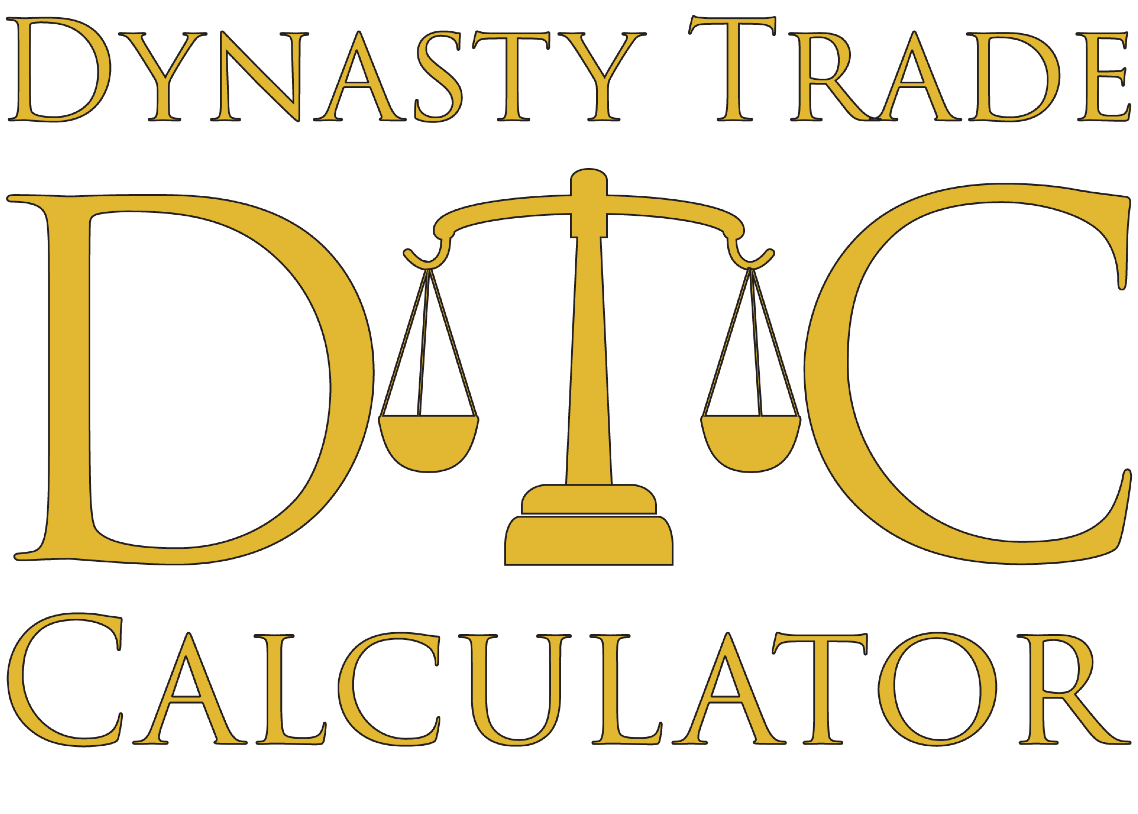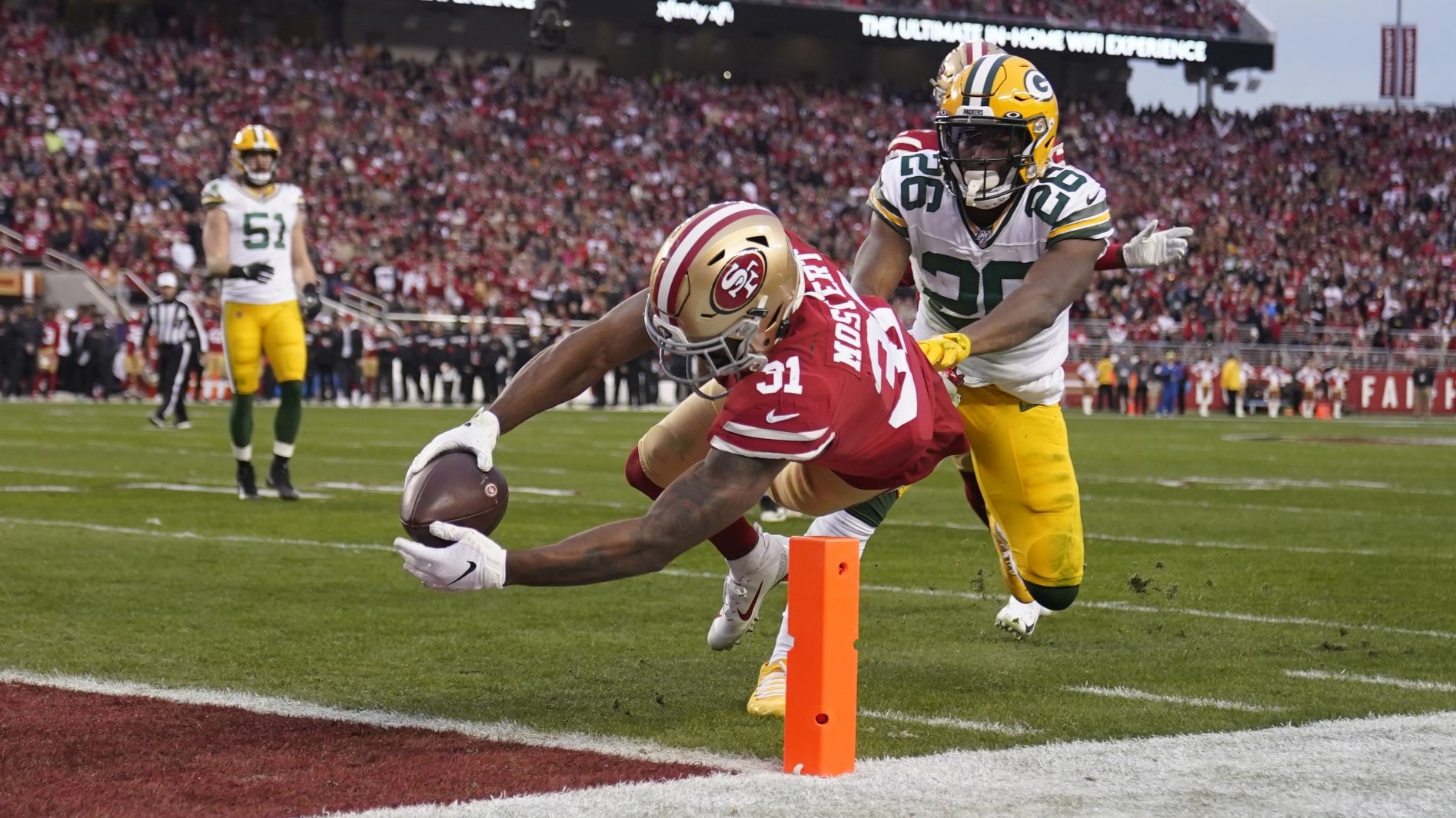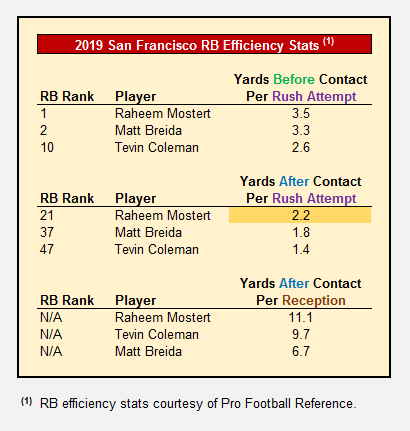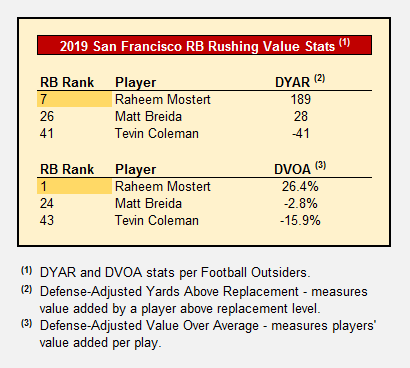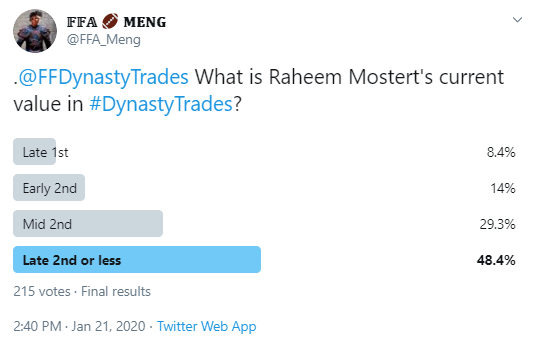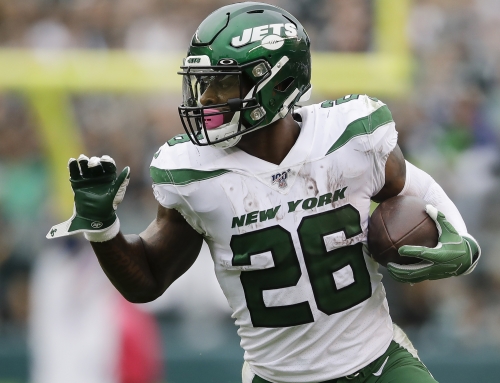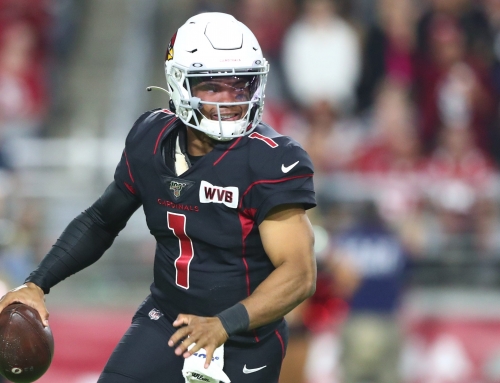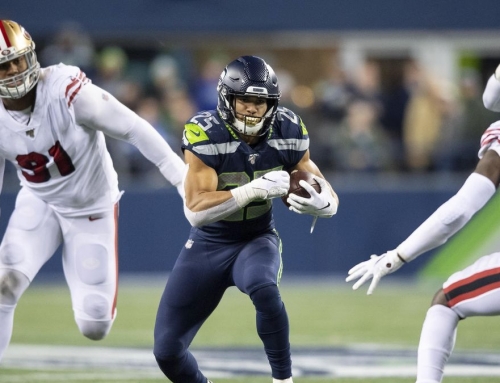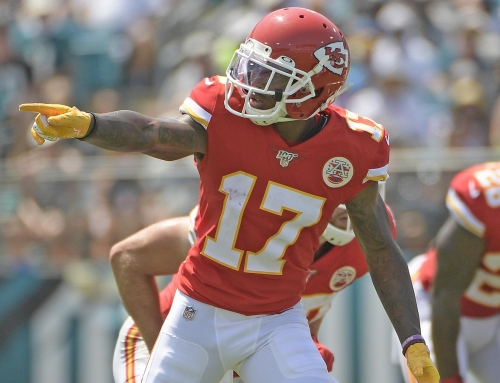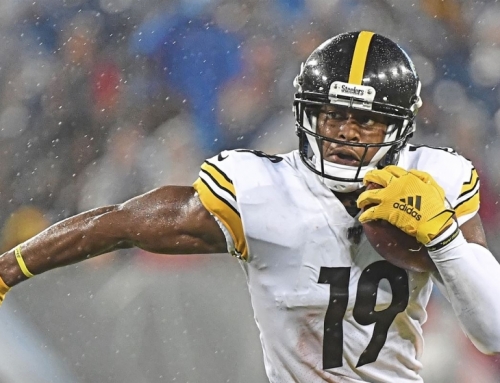I’ve seen countless tweets about selling high on Raheem Mostert in dynasty in the days following his incredible performance against the Packers in the NFC Championship game. The sheer volume of advice advocating Mostert as a sell indicates to me that he might actually be a candidate to buy right now. Yes, Mostert is unlikely to ever have another 220-yard performance or rush for four touchdowns in a single game again for the duration of his career. And yes, in all likelihood, Kyle Shanahan will continue to employ a committee backfield next year in San Francisco. However, neither of those statements precludes Mostert from being a sustainable fantasy RB2 or better in 2020.
Going into the 2019 season, the 49ers’ backfield was a hot topic. Everyone knew that San Francisco could produce a prolific run game on offense given Shanahan’s ingenuity and track record of success, and they were right. If the 2019 production for all four 49ers running backs were to be combined into one player, that player would’ve totaled 456.8 PPR points. This point total would’ve been good enough to rank as the no. 2 fantasy running back behind only Christian McCaffrey this past season and would’ve netted over 142 points more than the next best fantasy back in 2019, Aaron Jones.
The big question and debate in the preseason centered not around whether the 49ers’ running backs could be fantasy stars, but which running back would be the most productive. Injuries kept the backfield situation muddled for most of the year. A high ankle sprain in the season opener sidelined Tevin Coleman early on in the season, which led to Mostert splitting touches with Matt Breida and Jeff Wilson for the first three games until Coleman’s return in Week 5. All three backs found some measure of success in Coleman’s absence, but Wilson limited both Mostert and Breida’s fantasy ceilings, scoring four touchdowns (two each in Week 2 and Week 3) in his goal-line role.
But as the season progressed with the backfield mostly healthy, Mostert began to assert himself as the starter. Coleman had a massive three-score game against Carolina in Week 8, but he did so on just 11 carries. He also struggled in the subsequent four weeks despite leading the team in carries, though it’s worth noting that Coleman faced the highest percentage of snaps in the league this year with eight defenders in the box (40.2%) per NFL’s Next Gen Stats. It’s also worth noting that Coleman’s struggles as the lead back included a four-game stretch during which San Francisco was missing three key run blockers. From Week 6 through Week 9, the 49ers were without starting left tackle Joe Staley, right tackle Mike McGlinchey, and fullback Kyle Juszczyk.
Nonetheless, Coleman’s struggles continued even in Weeks 10 through 13 once those players had already returned to action. And although Coleman had a fairly long leash, likely stemming from Coleman and Shanahan’s tenure together on the Falcons, Shanahan eventually tired of Coleman’s inefficiency. Starting during the game against the Ravens in Week 13, Mostert assumed lead back duties, though the 49ers continued to use a committee. Coleman and Breida remained involved, but Breida’s role diminished further after fumbling twice against Atlanta in Week 15, ultimately costing them the game. Following Coleman’s reduction in touches during their Week 13 matchup against Baltimore, Mostert has been the clear starter in San Francisco, having handled nearly 60 percent of the touches in the 49ers’ backfield.
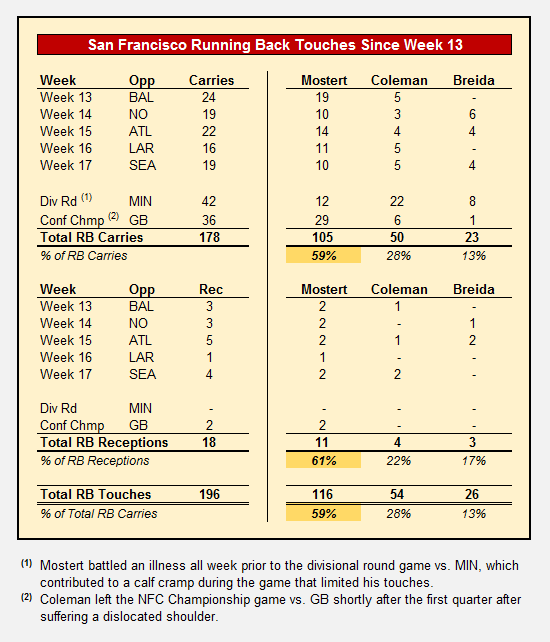
While Mostert clearly led the backfield in touches late in the season, that alone doesn’t guarantee his continued role in 2020. The argument has been made that any running back can succeed in Shanahan’s system with a strong offensive line, which is true to an extent. But while all the 49ers’ running backs benefited from good blocking and yards before contact, Mostert was the most efficient at gaining yards after contact, both as a rusher and as a receiver.
Mostert’s DYAR ranked seventh behind only Ezekiel Elliott, Christian McCaffrey, Mark Ingram, Aaron Jones, Kenyan Drake, and Derrick Henry and was better than that of running backs like Dalvin Cook and Nick Chubb. In fact, Mostert led the entire league in rushing DVOA. Mostert’s DYAR and DVOA (both stats are explained in the footnotes of the graphic below) put him in very good company, whereas Breida’s rankings were middling at best, and Coleman was near the bottom of the list in both categories.
Mostert is signed through 2021 on a very cheap deal only costing San Francisco about $3 million per year, so it’s nearly certain that he’ll remain with the 49ers for the next two seasons. Coleman is signed through 2020, but the 49ers could save almost $5 million next year if they choose to cut him this offseason, as there is no dead money on his contract. Breida will be a restricted free agent this offseason, and Wilson will be an exclusive rights free agent. And finally, there’s the nearly forgotten Jerick McKinnon, who is under contract through 2021, but the team could save almost $5 million if they choose to cut him with just $4 million in dead money.
So what is the most likely scenario this offseason? I would project Mostert to enter 2020 as the incumbent starter on an affordable deal, and Breida is likely gone if another team signs him for running back depth. The 49ers may or may not retain Wilson for another year on a minimal deal, but his touches on offense would likely remain minimal even if he stays. The bigger concerns revolve around Coleman and McKinnon, both of whose tenures in San Francisco are up in the air depending on what Shanahan and John Lynch decide.
Even though Coleman performed admirably at times, particularly against Minnesota in the playoffs with Mostert not fully healthy, he could still be expendable. While many are predicting McKinnon to be cut, from a pure fiscal standpoint, it may make more sense for the 49ers to see if he can get healthy and contribute. After all, they would save $5 million by cutting either him or Coleman, but there is no cap penalty for cutting Coleman compared to $4 million in dead money with McKinnon. Coleman’s $5 million cap hit might be better spent elsewhere with San Francisco only having about $16 million total in salary cap space, the sixth-least in the league. Their focus will presumably be to re-sign impending free agents like Juszczyk, their Pro Bowl fullback, and key contributors on defense like safety Jimmie Ward and defensive end Arik Armstead.
If I had to guess, my current projection for San Francisco’s 2020 backfield would be Mostert as the lead back with some combination of Coleman or McKinnon and a yet-to-be determined rookie or free agent signing behind Mostert. While the 49ers’ backfield will likely remain a committee, Mostert finished the 2019 season as the RB26 in PPR formats despite barely touching the ball for the first 12 games of the year. In a lead role or even a 1A role in such a proficient running offense, Mostert has a RB2 floor in fantasy with a RB1 ceiling. Even more impressive about the 49ers’ rushing production in 2019 is the fact that San Francisco had multiple injuries throughout the season to their run-blocking unit and still ranked eighth in run-blocking efficiency per Football Outsiders. All five starters on their offensive line are under contract through at least 2020.
Despite the calls to sell Mostert in dynasty, I’d argue that he’s worth buying given his lead role in an extremely productive 49ers rushing attack. Based on the Twitter poll results below, Mostert can be acquired in many leagues for a mid or late second-round rookie pick or less.
Any first-round rookie pick is probably too much given the strength of the 2020 rookie class as well as the fact that Mostert will be 28 years old at the start of next season. The biggest risk to Mostert’s value is a rookie running back addition to the backfield, but the 49ers are more likely to focus on bolstering their offensive line depth and adding to an already menacing defense with their early-round draft picks. But at the price of a mid to late second-round rookie pick, or even at the price of an early second-round pick, Mostert’s fairly safe RB2 floor and high fantasy ceiling for at least the 2020 season make him a worthwhile dynasty acquisition. Buy Mostert now before another potential price increase if he gashes a 28th ranked Chiefs run defense in the Super Bowl.
On a related note, McKinnon could be worth buying as well in dynasty (I’ve discussed him as a buy candidate before), as his price point is probably only a third-round rookie pick or less at this point. He’s a cheap hedge for those who already have Mostert on their dynasty rosters. And even if not, while it’s a long shot, McKinnon still has high fantasy upside if San Francisco retains him but moves on from Coleman this offseason.
For more fantasy football and dynasty content, follow me on Twitter @FFA_Meng.
